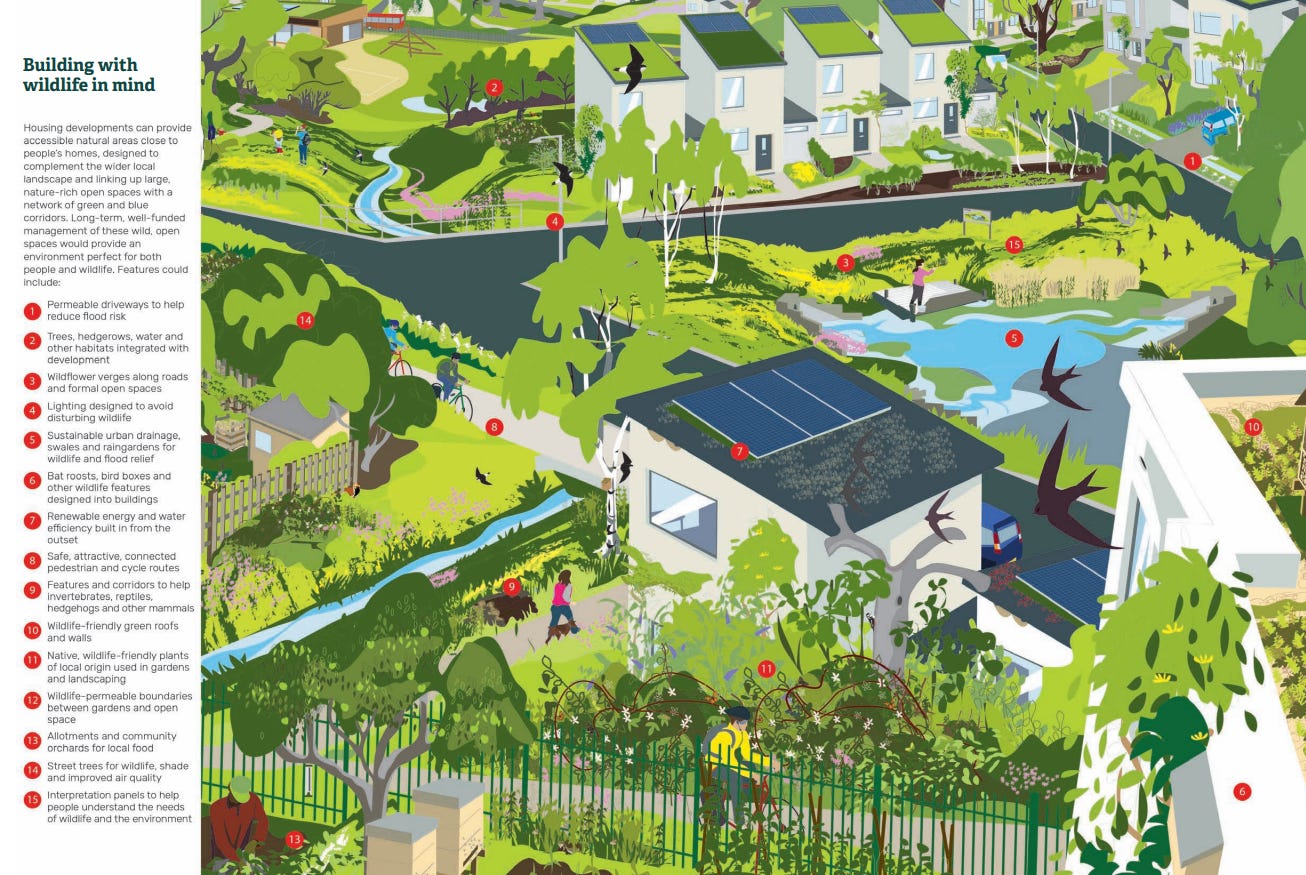What are nature-friendly neighbourhoods?
Can people and wildlife really live together?
Keir Starmer, boss of the Labour Party and leader of the opposition here in the UK, recently pledged to build 1.5 million houses if he were to win a general election, calling himself a “house-building yimby” and promising a “decade of renewal”.
I’m not an economist, so I’ll let you do the research on whether building more houses is a better solution to the housing crisis than addressing the cost of credit, but what I can tell you is that rampant urban development is one of the key drivers of nature loss in the UK - a country which is already one of the most nature-deprived in the world.
But people need somewhere to live, and our population is growing, so is it possible to create neighbourhoods that benefit people and nature together?
Of course it is.
What people don’t need are quickly assembled, cheaply made, poorly insulated houses in neighbourhoods without services that will create more problems than they solve and do nothing to help soaring energy bills.
What people do need are carefully designed, properly made, well insulated houses with easily accessible services that improve people’s living conditions and provide habitats for nature at the same time.
But what does that actually look like?
Back in 2018, the UK Government announced plans to build 300,000 new houses each year until 2022. The Wildlife Trusts responded with a wonderful guide on how exactly we can make these neighbourhoods work for people and nature together.
We should prioritise places for new housing that are already well served by infrastructure. We should avoid destroying wildlife sites and locate new houses in places where it can help to restore the landscape and aid natural recovery. It’s possible to create nature-friendly housing by planting wildlife-rich community green spaces, walkways, gardens, verges, roofs, wetlands and other natural features. These gains for wildlife improve people’s health and quality of life too.
Homes for People and Wildlife, the Wildlife Trusts
It’s completely possible to incorporate natural features into housing developments.

Living walls are vertical gardens that can climb up the sides of buildings, giving plenty of the benefits of green space without taking up additional room. By designing walls for vertical vegetation, housing can:
Increase urban biodiversity
Reduce air pollution
Reduce the urban heat island effect, cooling buildings
Improve insulation
Reduce noise pollution
Improve people’s mental wellbeing
And that’s just through designing a few walls a little differently than normal. So let’s scale up our ambitions and see what else we can achieve, with:
Pollinator-friendly wildflowers on verges
Cycle paths and pavements to encourage low-carbon transport
Permeable driveways and green space to reduce flooding
Wildlife corridors to provide safe avenues for foxes, badges, hedgehogs and other mammals
Nesting boxes for bats, swifts, swallows and other birds
Allotments and community orchards to provide local food and build social resilience
Trees for shade and wildlife
Heat pumps and solar panels to provide low carbon energy and reduce stress on the national grid
Ponds and mini-wetlands to increase aquatic biodiversity and mental health
Within the same report, the Wildlife Trusts created a wonderful graphic to visualise all this wonderful fun stuff together. Despite being a few years old the message is still as relevant as ever.

You could attribute the climate and nature crises currently unfolding in front of our eyes to a lack of imagination. We know what causes these problems - over-reliance on fossil fuels, polluting pesticides, and unsustainable development - but how can we create a better future if we can’t imagine an alternative?
I’ve been thinking about this a lot recently, so you can expect a deeper dive in the coming weeks, but it all comes down to redefining what is normal. If, for example, it was normal that every time you opened your kitchen cupboard the contents flew out and hit you in the face, I doubt you’d put up with it for very long. You would fix it. So why should we continue to pursue a way of living that we know is destroying us? By blindly pursuing an unsustainable system we’re just committing to a world in which nature continues to decline and temperatures continue to soar.
Until now, we’ve focused on designing our urban spaces for people. But if we don’t start designing them for nature as well, we’re going to have to continue to face the crises that are escalating every day.
I know which option I’d choose.


